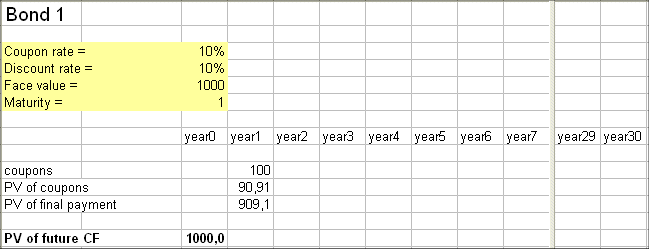
Wednesday December 8th 2004
Finance : session 9 bonds part 2
Second hand bonds
A remark on risk patterns
The NPV of a second hand bond too is zero
Circular arguments
Movements in rates and movements in prices of second hand bonds
The value of a bond over its life
Summary
Exercises
NYT
article : "Dollar's Fall Tests Nerve of Asia's Central Bankers"
China reduces holding of US
treasury bonds
We saw in part 1 the trading of new bonds. But second hand bonds are traded too.
Once we bought a new bond nothing prevents us from selling it to somebody else before the end of its life. We only have to find a buyer and agree upon a price.
The price of a second hand bond is usually different from its face value.
How is the price of a second hand bond set ?
To answer this question, let's look more precisely at a second hand bond. Suppose we bought, two years ago, a 7 year maturity bond, with coupons $80. The initial total stream of future cash flows, as we know, was this :
| Year0 | Year1 | Year2 | Year3 | Year4 | Year5 | Year6 | Year7 | |
| Future coupons | 80 | 80 | 80 | 80 | 80 | 80 | 80 | |
| Future final refund | 1000 | |||||||
| Initial purchase | -1000 |
But now we are year 2 (it is the new year 0) !
So, viewed from today, the present stream of future cash flows becomes this :
| Year0 | Year1 | Year2 | Year3 | Year4 | Year5 | |
| Future coupons | 80 | 80 | 80 | 80 | 80 | |
| Future final refund | 1000 | |||||
| Selling price |
? |
The question is : "How much to sell this bond for ?", or equivalently "How much a buyer will be willing to pay for it ?"
Answer : Well, for the potential buyer, this is a five year maturity bond, with $80 coupons, and a final payment of $1000.
The buyer will apply the standard DCF analysis to compute the value to him of this future stream of cash flows.
The initial parameter to figure out is : "What is the opportunity cost of capital of this second hand bond ?"
The standard answer goes like this : "It is the going coupon rate of new 5 year bonds, because the risk pattern of the second hand bond (with 5 years left) is the same as the risk pattern of a new 5 year bond ; and the risk pattern of a new five year bond is the same as that of a security with a profitability equal to its coupon rate."
Rate structures and rates change over time. Suppose the going rate of new 5 year bonds is 10%. Then the opportunity cost of capital of the second hand bond with 5 years left, viewed by the potential buyer, is 10%.
So the potential buyer will make the following calculations :
| Bond calculations | ||||||
| Coupon rate = | 8,00% | |||||
| Discount rate = | 10,00% | |||||
| Face value = | 1000 | |||||
| Maturity = | 5 | |||||
| year0 | year1 | year2 | year3 | year4 | year5 | |
| coupon | 80 | 80 | 80 | 80 | 80 | |
| PV of coupon | 72,73 | 66,12 | 60,11 | 54,64 | 49,67 | |
| PV of final payment | 620,92 | |||||
| PV of all the CF | 924,1843 |
The buyer will be willing to pay us $924.2 for our bond. It is the going price of our second hand bond.
The buyer followed a reasoning which has the following implicit consequence :
the two sequences of cash flows
| 80 | 80 | 80 | 80 | 1080 | |
| 92,4 | 92,4 | 92,4 | 92,4 | 924,2 |
have the same risk pattern, and the same opportunity cost of capital (10%), and the same value today ($924,2)
That these two streams of cash flows have the same risk patterns is not "obvious" ; it is either true or false within a probabilistic model and a definition of risk pattern. (And we saw that investors dislike risk, and, for a narrower risk pattern, will accept to have less profitability.)
Of course a consequence is that : The NPV of a second hand bond too is zero
In dealing with bonds, and more generally in Finance, it is easy to fall into fallacious circular arguments. : A is true because of B, which is true because of C, which is true because of D, and D is confirmed because it is equivalent to A... Only clear models prevent one from straying from standard logic and fall into circular arguments. But when models are ill constructed it is easy to grope from a mixture of arguments from intuition, "obviousness", experience, and shaky logic, which in fact hide a circular argument.
Movements in rates and movements in prices of second hand bonds :
We showed a fundamental rule about bonds :
And when rates decrease, the value of second hand bonds increase.
Let us study this rule in depth.
Here are two 10% coupon new bonds, bond B1 one with maturity one year, and bond B2 with maturity 30 year. First of all here are their stream of cash flow and their present value, when the discount rate is the same as the coupon rate.

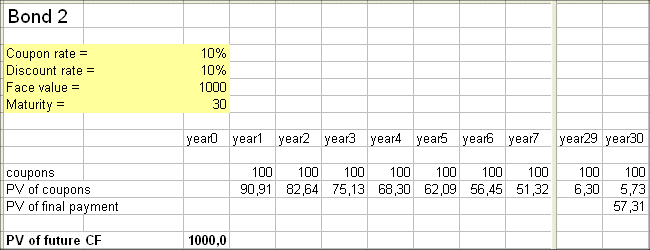
Now we want to study what happens to the Present Value of the future stream of cash flow if there is a change in the discount rate (i.e. the opportunity cost of capital) right after the issuance of the bonds.
If the discount rate falls to 5% :
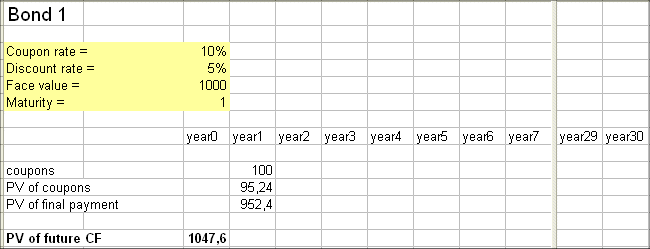

We see an important effect : both bond values go up, but the increase is much stronger for the long maturity bond.
Conversely, we can find (using the spreadsheet) that when the opportunity cost goes up both PV fall, but the effect again is much stronger for the long maturity bond.
Here is the whole plot of the change in PV as a function of the new opportunity cost of capital :
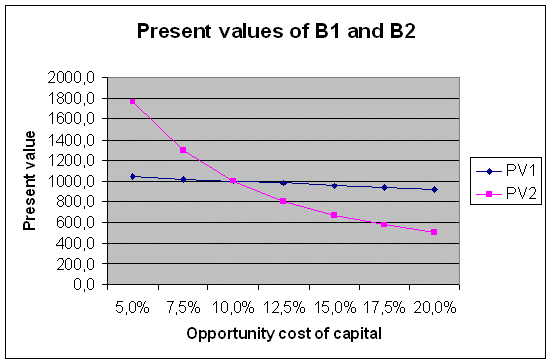
| PV1 | PV2 | |
| 5,0% | 1047,6 | 1768,6 |
| 7,5% | 1023,3 | 1295,3 |
| 10,0% | 1000,0 | 1000,0 |
| 12,5% | 977,8 | 805,8 |
| 15,0% | 956,5 | 671,7 |
| 17,5% | 936,2 | 574,8 |
| 20,0% | 916,7 | 502,1 |
Exercise : check the numbers by yourself.
So we can complete our rule above :
Value of a bond over its life :
Here is another fact we should pay attention to concerning change in opportunity cost of capital and the resulting changes in present value.
Suppose we purchased a new bond, 10% coupon, 12 year maturity. Fine.
Suppose right after its issuance, the discount rate for similar bonds goes up to 15%. We know that we somehow got gyped : the value of our bond dips right away to $729.
Now suppose the rate for all new bonds remains at 15% for the next following 12 years, no matter the maturity of the new bonds (this is a "school example" :-) )
What will happen to the value of our bond ?
Well right away it plunged to $729.
But next year ?
Next year it will be like a new 10% bond with maturity 11 years, and an opportunity cost of capital of 15%. Value : $738,3
Year 2 : $749,1
etc.
Whole graph :
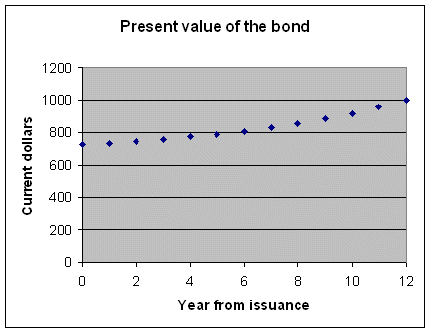
This is an illustration of the variation in the value of a bond according to the economic circumstances, which are : 1) how far the bond is from its end, 2) what is the current rate for similar new bonds.
(The last figure of $1000 is not very meaningful : it just means, right after the final coupon has been paid, the present value of $1000 right now is $1000.)
The above graph does not correspond to a realistic situation (because it forgets rate structures), but what is true is that no matter what the circumstances are, a bond with face value $1000, if it is close to the end of its life, has a current value not far from $1000.
Put another way, the effect on the value of the bond of changes in the correct discount rate (i.e. the opportunity cost of capital) is all the stronger on bonds which still have a long life in front of them.
Bonds are one of the two fundamental ways firms can finance themselves. The other one is issuing Equity.
The financial contract represented by a bond is different from the contract represented by equity. In the first case there is usually no notion of property rights transfered to the bond holder. Whereas the purchase of a stock gives us a property title on a firm, the right to participate into the strategic as well as managerial decisions about the firm, and the right to receive a fraction of dividents when some are distributed (and, in theory, we took part in the decision to distribute dividends).
Firms can borrow from banks, but this is just a variety of bond issuance.
Other economic agents issue bonds too : governments and municipalities. (And they also borrow money from banks.)
Mortgaged bonds to finance the purchase of houses are a an important subfield of the field of bonds.
We shall study later various types of financial tools to exchange value and risk between economic agents, a big word to say "the buying and selling of securities of all types".
1) I have a 10% coupon bond in my pocket. Its maturity is in 14 years. I want to sell it. The current coupon rate for new 14 year bonds is 7%. How much should I ask for it ?
Ans : $1262,4
2) You purchased, in 1989, 30 year maturity US Treasury bonds, the going coupon rate they offered then was 6%.
Today the rate for 15 year bonds is (about) 4,5%.
What is the value of your bonds ?
Ans : $1161,1 per bond.
3) You inherited from your grand parents Russian bonds issued in 1900, with rate 10% and maturity 100 years ("school example", check history for the exact characteristic of these bonds) :
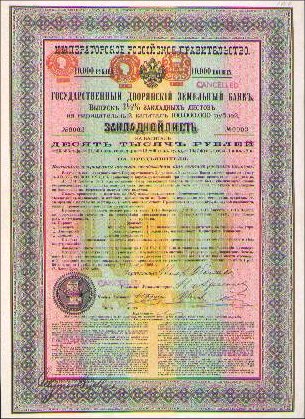
How much were they worth in 1980 ? Discuss.
4) Because you exported a lot to the US, and received a lot of dollars that you converted into securities that at the same time are safe and "work" (and don't stay "idle" like dollars do), you hold US TB issued in 2000, rate 6%, maturity 30 years. How much will they be worth in 2020 ? Discuss. How much are they worth today ? Discuss. Was it a good deal to buy them ? Discuss. Should you sell them ? Discuss.
5) check a few of the sites pointed to by the search "US treasury bonds" IMAGES, on google
http://images.google.fr/images?sourceid=navclient&hl=fr&ie=UTF-8&q=US+treasury+bonds
Understand the relationship between Finance and History.

View some old bonds (governements and corporations) : http://www.antiquestocksandbonds.com/catalog.htm
Remember : bonds are promises (money too, we shall study this next semester).
NYT article : "Dollar's Fall Tests Nerve of Asia's Central Bankers"
Mr. Asakawa, 46, is the top official at the Finance Ministry here responsible for managing the largest portfolio of United States government securities in the world, worth a staggering $720 billion. As the dollar has slumped this fall, many investors have started to worry that Mr. Asakawa and his counterparts elsewhere in Asia will be tempted to pare their holdings, perhaps causing the currency to plunge much further and setting off a round of interest rate increases in the United States that could send the global economy into a tailspin. But Mr. Asakawa, at least for now, says that he intends to keep right on adding American holdings to Tokyo's portfolio. ''We've heard the rumors in the last few days that the Chinese guys, the Indian guys, the South African guys are diverting from dollars,'' Mr. Asakawa said. ''We have no plan at all to divert from our dollar-denominated assets.'' Still, Mr. Asakawa admits that he has not been sleeping so well lately. ''This thing wakes me up; it is terrible,'' Mr. Asakawa said in excellent American-accented English -- he once studied at Princeton -- as he toyed with a blue plastic portable currency monitor. After hours, the wireless device beeps by his bedside whenever the dollar strays beyond a set range. ''Fortunately,'' he said, ''my wife is very understanding.'' Mr. Asakawa has been waking up a lot more often because the long-running symbiotic relationship between Asia and the United States has started to fray. For years, manufacturers in Japan, China, South Korea and Taiwan have been selling far more to Americans than Asians have been buying from the United States. As a result, Asians have accumulated huge quantities of foreign exchange, which they have used mostly to buy American government securities. By doing so, they helped keep interest rates in the United States low and the dollar relatively strong. That allowed Americans to borrow cheaply and fill their shopping bags with yet another load of well-priced goods imported from Asia. Low interest rates also enabled Washington to readily finance the federal government's gaping budget deficit. But as borrowing by the United States from abroad has soared this year to $620 billion, a record 5.7 percent of overall economic activity, many foreigners have become reluctant to keep accumulating dollars at the same pace. That has left officials like Mr. Asakawa and others at central banks elsewhere in Asia holding America's purse strings. Japan's total stockpile of foreign currency, at $817 billion, is still the largest in the world, but China, which now owns about $600 billion, is catching up fast. Among countries that are accumulating dollars -- especially China -- grumbling is on the rise that Washington should do more to protect the value of their investments by cutting the budget deficit and adopting other policies to slow or reverse the dollar's decline. ''Shouldn't the relevant authorities be doing something about this?'' asked Prime Minister Wen Jiabao of China at a conference in Laos last Sunday. In Beijing these days, one of the fastest-growing fortunes the world has ever seen is managed by fewer than two dozen traders, chosen for showing mathematical brilliance at China's top universities. Generally lacking any financial experience outside China, they sit at trading stations around a gold stand bearing a jeweled globe, two feet in diameter and with seas of lapis lazuli, in a rented room on the fourth floor of an insurance building. Most of the money in China's central bank coffers has accumulated in the last four years, the product of an investment torrent washing over China and the ever-expanding flood of goods pouring out of Chinese factories. As in Japan and China, small groups of civil servants in Taiwan and South Korea are struggling to invest sizable foreign currency reserves of $235 billion and $193 billion, respectively. For years, all four countries have held the bulk of their reserves in the Treasury bills, notes, and bonds that finance the federal budget deficit, leaving American consumers and companies free to spend more on other things and invest their spare cash in more promising ventures. Together, these Asian institutions are responsible for holding roughly 40 percent of the American government's public debt. In contrast to Japan, China's money managers, while selling little of their existing Treasury holding, have not been buying much more. China's foreign currency reserves rose by $111.3 billion in the first three quarters of the year, according to official Chinese data. But its Treasury holdings, American filings show, climbed by only $16.4 billion. Instead, officials at the State Administration of Foreign Exchange in Beijing have been seeking higher yields by plowing billions of dollars a month into bonds backed by mortgages on houses across the United States, according to bankers who help Beijing manage the money. By helping keep mortgage rates from rising, China has come to play an enormous and little-noticed role in sustaining the American housing boom. The proportion of China's hoard in Treasury securities has dropped to about 35 percent, they say, compared with the roughly 90 percent of Japan's foreign currency reserves still parked in Treasury securities. Some bankers and economists say that dollar-denominated securities over all represent a slowly declining share of China's recent purchases. But no figures are available on how quickly Beijing may be shifting to other currency holdings, so its effect on the underlying demand for dollars is unclear. Still, the American reliance on foreign money and the investment decisions of bankers halfway around the world underline a serious risk for the economy: What would happen if this deep investment pool was used to fill coffers elsewhere in the world, perhaps in Europe or in Asia itself? With the dollar trading in recent days around five-year lows against the Japanese yen, Russia's central bank unnerved currency markets last week by revealing that it was considering diversifying from dollars to euros. A Chinese central banker, Yo Yongding, also caused a brief dive for the dollar on Nov. 26 by making remarks that were initially translated as a statement that Chinese dollar holdings were dropping. The banker later issued a statement that he had noted only that the value of Chinese-held Treasuries had dropped with the falling value of the dollar. For all the interest in the other players, currency markets remain focused on Japan, which has aggressively bought dollars, doubling its investment in Treasuries over the last two years. During a 15-month period that ended in March, the Japanese government bought $340 billion of dollar-denominated securities with its yen. The buying spree so stunned speculators that Japan has not had to intervene in the markets since. But now with Japan's huge stake in the dollar losing value, the question is, What will Tokyo do next? The problem for Japan is that it is in so deep that to a large degree it is chained to its American debtor. ''Imagine that tomorrow people hear, 'Hey, Japan has decided to divert from U.S. dollars to euros,''' Mr. Asakawa said. ''That would create a hugely undesirable impact on the U.S. Treasury market, and we have no intention at all to make an unfortunate impact on the U.S. Treasury market.'' Any selling move by Japan would move the entire market -- and cut further into the value of Japan's own portfolio. Richard Koo, chief economist for the Nomura Research Institute, is one of many financial soothsayers in Tokyo who work to divine the thinking behind the shabby door on the fourth floor of the gray pre-World War II Finance Ministry building marked Director of Foreign Exchange Markets. As he sees it, anything Japan might do to slow its dollar purchases would only create a self-inflicted wound. ''If they could move it all out of dollars in one day, I am sure they would do it in an instant,'' Mr. Koo said. ''But if they move 10 percent, and the dollar goes down 20 percent, they are stuck with 90 percent of the portfolio worth 20 percent less.'' Others in Japan are not happy about how much the dollar has already weakened. Toyota, Japan's largest company and its biggest exporter, complains that for every 1-yen gain against the dollar, the company's annual profit falls by 20 billion yen, currently $195 million. With Japan's economic recovery still lagging, its dollar buying serves to help keep its exports more competitive. This week, Japanese officials have been talking up the dollar and leaving the door open to a resumption of specific dollar-strengthening moves. On Wednesday, Mr. Asakawa's boss, Hiroshi Watanabe, vice minister for international affairs at the Finance Ministry, responded to a question at a news conference about intervention saying, ''There is nothing to limit our actions; there are no such concerns.'' Japan and China hold too much American debt to be able to diversify discreetly. Instead, they are urging the Bush administration, in public and private, to get the American budget into better balance and to improve American saving rates. ''What China and Japan are trying to do is say, 'Please get back on track with fiscal reform,''' said Robert A. Feldman, chief economist for Morgan Stanley Japan. China, more than many countries, treats its foreign currency reserves as not just a way to control the value of its currency in international markets but also as a form of national savings. That is one reason its traders are encouraged to take greater risks in search of higher returns. China used $45 billion from its stash to bail out the state-owned Bank of China and the China Construction Bank last winter. People close to Chinese policy makers predict that another $50 billion to $60 billion will be used this winter to bail out the much larger Industrial and Commercial Bank of China, also state-owned, and possibly a smaller sum to help the Agricultural Bank of China. The Chinese government currency traders, bankers say, have refrained from the kind of highly speculative trading that led to the $550 million in losses disclosed this week by the China Aviation Oil (Singapore) Corporation, which is majority owned by a state-run Chinese company. But the fees and commissions associated with doing business with the Chinese has prompted many big Western banks to set up special trading teams in Hong Kong just to handle transactions for Beijing. An important job for such teams involves taking Chinese traders to dinner, Western bankers say, as the Chinese are not allowed to accept gifts. So fee-hungry bankers fly regularly to Beijing from Hong Kong -- some making the trip practically every week -- to take traders out for lavish evenings. For some, one banker said, this duty can become wearisome. The Chinese
traders enjoy bowling, he said, but they also have a reputation for wanting
to attend Mandarin romantic operas, an acquired taste at best.
Photo: Masatsugu Asakawa says that he intends to keep adding American
holdings to Japan's portfolio. (Photo by Elena Aframova for The New York
Times)(pg. C2) |
|
|
Copyright 2004 The New York Times Company |
China reduces holding of US treasury bonds
December 6, 2004 Beijing Time
China reduces holding of US treasury bonds
According to China Business News, the ever growing current account adverse balance and financial deficit in the United States have resulted in constant weakening of US dollars in the latest three years. On November 25, the exchange rate between Euros and US dollars at 1:1.3237 set up the highest point ever since Euros came into being. Furthermore, from the beginning of this year the exchange rate between Euros and US dollars has risen by about 7 percent.
China's foreign exchange reserves have been calculated by US dollars. Among China's over US$500 billion foreign exchange reserves, 80 percent are US dollars assets, in which most of them are used to buy US treasury bonds. The drop of US dollars inevitably brings about shrink of foreign exchange reserves. If China converts 80 percent of its US dollar assets into Euros, almost US$40 billion of its more than US$500 billion foreign exchange reserves have vaporized in the past half year since May 13.
Facing the descending trend of US dollars people begin to worry about that China's huge amount of foreign exchange reserves will shrink by significant margin.
Member of the Currency Policy Commission of the Central Bank Mr. Yu Yongding notes: China has taken precautions. The rate of US dollar assets in China's foreign exchange reserves has declined.
On November 25 Mr. Yu revealed at the seminar of "Asian Financial Cooperation and International Financial Issues" at Shanghai University of Finance and Economics that China has begun reducing US dollar assets in its foreign exchange reserves, in which the growing pace of holding US treasury bonds has slowed down in 2004. The current total volume is approximately US$180 billion.
In recent years the growth of China's foreign exchange reserves has been fairly rapid. From 1993 to 2003, China's foreign exchange reserves have grown from US$21.2 billion to US$403.3 billion. And by the end of China has held US$158.089 billion US treasury bonds, which accounted for 39.2 percent of China's foreign exchange reserves.
From January to September 2004 China's foreign exchange reserves increased by US$111.2 billion and reached US$514.5 billion. Meanwhile, US treasury bonds only increased US$16.31 billion. The rate of US treasury bonds in China's foreign exchange reserves declined to 33.9 percent, dropped by 5.3 percent points.
China adjusted its capital structure through reducing holding of US treasury bonds in its foreign exchange reserves. Obviously, while China tries to avoid losses, the prospect of US dollars will be more gloomy.
The news that China's central bank has reduced the rate of US treasury bonds in its foreign exchange reserves has aroused sensational feedbacks in the world market. On November 26 the exchange rate of US dollars to Euros hit another new lowest point. And various term bonds in the US market went down generally.
Mr. Zhong Wei, Director of Financial Research Center of Beijing Normal University states that such reaction reflects extreme disbelief to US dollars in the international market.
"From the perspective of financial psychology the market has entered Panic Transition Period", he says.
Mr. Zhong points out that US current account deficit accounts for 50 percent of its GDP. The rate of financial deficit in GDP is 4 percent. The United States should have at least US$1 trillion capital inflow to maintain capital balance.
Japan and China are the biggest buyers of US treasury bonds, holding approximately US$900 billion together. The reduction purchase of US dollar assets by Japan and China will definitely bring about significant effects to the US dollars.
Last Updated(Beijing Time):2004-12-06 16:36